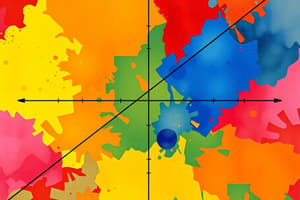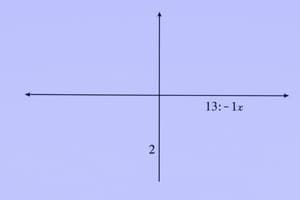Podcast
Questions and Answers
What is the limit of f(x) as x approaches 3 from the right?
What is the limit of f(x) as x approaches 3 from the right?
- 0
- Does not exist
- 1
- ∞ (correct)
What does it mean if the limit from the left does not equal the limit from the right?
What does it mean if the limit from the left does not equal the limit from the right?
- The limit does not exist. (correct)
- The function is continuous at that point.
- The limit exists.
- The function has a removable discontinuity.
Based on the limit calculations, what can be inferred about f(x) at x=3?
Based on the limit calculations, what can be inferred about f(x) at x=3?
- f(3) does not exist. (correct)
- f(3) is defined.
- f(3) approaches a finite number.
- f(3) is equal to 0.
Which rule applies when estimating limits from a graph?
Which rule applies when estimating limits from a graph?
What does the notation lim− f(x) indicate?
What does the notation lim− f(x) indicate?
What happens to f(x) as x approaches 1 from the right?
What happens to f(x) as x approaches 1 from the right?
What does the limit of f(x) equal when x approaches 1 from both sides?
What does the limit of f(x) equal when x approaches 1 from both sides?
How does f(x) behave as x approaches 3 from the right?
How does f(x) behave as x approaches 3 from the right?
What is the form of the expression given for the limit of f(x)?
What is the form of the expression given for the limit of f(x)?
What does the notation lim− f(x) signify?
What does the notation lim− f(x) signify?
What is the primary characteristic of the function f(x) near x = 1?
What is the primary characteristic of the function f(x) near x = 1?
What happens to the function f(x) as x approaches 4 from the left?
What happens to the function f(x) as x approaches 4 from the left?
When x = 3.9999, what is the value of f(x)?
When x = 3.9999, what is the value of f(x)?
Which of the following values of x is approaching 4 from the left?
Which of the following values of x is approaching 4 from the left?
As x approaches 4 from the right, which of the following is true?
As x approaches 4 from the right, which of the following is true?
What mathematical operation is needed to evaluate f(x) = 3x^2 - 1?
What mathematical operation is needed to evaluate f(x) = 3x^2 - 1?
Which of the following best describes the method used to examine the limit of f(x)?
Which of the following best describes the method used to examine the limit of f(x)?
What is the significance of the notation lim x->4 in the context of limits?
What is the significance of the notation lim x->4 in the context of limits?
What does the term 'limit' refer to in mathematics?
What does the term 'limit' refer to in mathematics?
How is the limit of a function denoted?
How is the limit of a function denoted?
Which statement about limits is true?
Which statement about limits is true?
Which of the following methods is NOT a way to find the limit of a function?
Which of the following methods is NOT a way to find the limit of a function?
What is the limit of the function f(x) = 3x^2 - 1 as x approaches 4?
What is the limit of the function f(x) = 3x^2 - 1 as x approaches 4?
When evaluating limits, which of the following is NOT considered significant?
When evaluating limits, which of the following is NOT considered significant?
What does 'x approaching c from the left' mean?
What does 'x approaching c from the left' mean?
Which of the following statements about the limit of a function is true?
Which of the following statements about the limit of a function is true?
What can be inferred about the function f(x) as x approaches 1 from the right?
What can be inferred about the function f(x) as x approaches 1 from the right?
What is the significance of creating a table of values for x approaching 1?
What is the significance of creating a table of values for x approaching 1?
How does f(x) behave as x approaches 1 from the left, based on the graph?
How does f(x) behave as x approaches 1 from the left, based on the graph?
What is the expected limit of f(x) as x approaches 1 from both sides?
What is the expected limit of f(x) as x approaches 1 from both sides?
Which of the following values is used to estimate lim f(x) as x approaches 1 from the left?
Which of the following values is used to estimate lim f(x) as x approaches 1 from the left?
If the limit of f(x) as x approaches 1 from the right is not defined, which statement is true?
If the limit of f(x) as x approaches 1 from the right is not defined, which statement is true?
Why might it be important to examine the behavior of f(x) as x approaches 1?
Why might it be important to examine the behavior of f(x) as x approaches 1?
What is the limit as x approaches infinity for a polynomial function of the form $ax^n$ where $a$ is a constant?
What is the limit as x approaches infinity for a polynomial function of the form $ax^n$ where $a$ is a constant?
What is the limit of $f(x) =
rac{1}{x}$ as x approaches infinity?
What is the limit of $f(x) = rac{1}{x}$ as x approaches infinity?
Which of the following represents the limit of a rational function as x approaches infinity?
Which of the following represents the limit of a rational function as x approaches infinity?
What happens to $a + ∞$ where a is a constant?
What happens to $a + ∞$ where a is a constant?
What is the outcome of $
rac{∞}{a}$ when a is not equal to zero?
What is the outcome of $ rac{∞}{a}$ when a is not equal to zero?
For which of the following is the limit at infinity equal to 0?
For which of the following is the limit at infinity equal to 0?
What is the limit of $f(x) = x^3$ as x approaches negative infinity?
What is the limit of $f(x) = x^3$ as x approaches negative infinity?
How does $a imes ∞$ behave when a is a positive constant?
How does $a imes ∞$ behave when a is a positive constant?
What is the limit of $
rac{1}{x^p}$ as x approaches infinity for p > 0?
What is the limit of $ rac{1}{x^p}$ as x approaches infinity for p > 0?
What is the limit of $f(x) =
rac{5x^4 + 3}{2x^4 - 1}$ as x approaches infinity?
What is the limit of $f(x) = rac{5x^4 + 3}{2x^4 - 1}$ as x approaches infinity?
Flashcards
Limit of a function
Limit of a function
The value a function approaches as its input (x) gets closer and closer to a specific number (c), without necessarily reaching that number.
lim f(x) = L
x → c
lim f(x) = L x → c
The notation used to represent the limit of a function f(x) as x approaches a specific value c. It states that as x gets closer and closer to c, the function's value approaches L.
x approaches c from the left (x → c⁻)
x approaches c from the left (x → c⁻)
When x approaches c from the left, meaning x takes values less than c and gets progressively close to c.
x approaches c from the right (x → c⁺)
x approaches c from the right (x → c⁺)
Signup and view all the flashcards
Limit independence
Limit independence
Signup and view all the flashcards
Estimating limit from a table
Estimating limit from a table
Signup and view all the flashcards
Estimating limit from a graph
Estimating limit from a graph
Signup and view all the flashcards
Estimating limit using algebra
Estimating limit using algebra
Signup and view all the flashcards
Right-hand limit approaches infinity
Right-hand limit approaches infinity
Signup and view all the flashcards
Left-hand limit approaches infinity
Left-hand limit approaches infinity
Signup and view all the flashcards
Limit does not exist (DNE)
Limit does not exist (DNE)
Signup and view all the flashcards
Estimating a Limit
Estimating a Limit
Signup and view all the flashcards
Left-hand Limit
Left-hand Limit
Signup and view all the flashcards
Right-hand Limit
Right-hand Limit
Signup and view all the flashcards
Limit Existence Condition
Limit Existence Condition
Signup and view all the flashcards
Limit Approaching Infinity
Limit Approaching Infinity
Signup and view all the flashcards
Table Method for Limits
Table Method for Limits
Signup and view all the flashcards
Algebraic Limit Evaluation
Algebraic Limit Evaluation
Signup and view all the flashcards
Graphical Limit Evaluation
Graphical Limit Evaluation
Signup and view all the flashcards
Limits in Calculus
Limits in Calculus
Signup and view all the flashcards
Approaching a number from the left (x → a-)
Approaching a number from the left (x → a-)
Signup and view all the flashcards
Approaching a number from the right (x → a+)
Approaching a number from the right (x → a+)
Signup and view all the flashcards
Evaluating a limit numerically
Evaluating a limit numerically
Signup and view all the flashcards
Limit exists
Limit exists
Signup and view all the flashcards
Limit does not exist
Limit does not exist
Signup and view all the flashcards
lim f(x) as x approaches 1 from the left
lim f(x) as x approaches 1 from the left
Signup and view all the flashcards
lim f(x) as x approaches 1 from the right
lim f(x) as x approaches 1 from the right
Signup and view all the flashcards
lim f(x) as x approaches 1
lim f(x) as x approaches 1
Signup and view all the flashcards
How to find lim f(x) as x approaches 1 from the left using a graph
How to find lim f(x) as x approaches 1 from the left using a graph
Signup and view all the flashcards
How to find lim f(x) as x approaches 1 from the right using a graph
How to find lim f(x) as x approaches 1 from the right using a graph
Signup and view all the flashcards
How to find lim f(x) as x approaches 1 using a table
How to find lim f(x) as x approaches 1 using a table
Signup and view all the flashcards
When does the limit of a function exist?
When does the limit of a function exist?
Signup and view all the flashcards
How to find the limit of a function using a graph
How to find the limit of a function using a graph
Signup and view all the flashcards
lim f(x) as x approaches infinity
lim f(x) as x approaches infinity
Signup and view all the flashcards
lim f(x) as x approaches negative infinity
lim f(x) as x approaches negative infinity
Signup and view all the flashcards
Limit at infinity of polynomial function
Limit at infinity of polynomial function
Signup and view all the flashcards
Limit at infinity for functions 1/x
Limit at infinity for functions 1/x
Signup and view all the flashcards
Limit at infinity for rational functions
Limit at infinity for rational functions
Signup and view all the flashcards
Limit at infinity - numerator power greater
Limit at infinity - numerator power greater
Signup and view all the flashcards
Limit at infinity - denominator power greater
Limit at infinity - denominator power greater
Signup and view all the flashcards
Limit at infinity - equal powers
Limit at infinity - equal powers
Signup and view all the flashcards
Infinity addition
Infinity addition
Signup and view all the flashcards
Infinity division
Infinity division
Signup and view all the flashcards
Study Notes
Limits of Functions
- Limits are based on the concept of "getting closer" to a value without actually reaching it.
- The limit of a function (as x approaches a) exists if and only if the limit from both sides (left and right) are equal.
- A limit can be examined through a table, a graph, or algebraically.
- Graphically, a limit is the value a function approaches as x gets closer to a particular value.
Properties of Limits
- Property 1: Limit of a constant: lim c = c, where c is a constant.
- Property 2: Limit of a power of x: lim xn = an , where a is a constant.
- Property 3: Limit of a sum: lim [f(x) + g(x)] = lim f(x) + lim g(x)
- Property 4: Limit of a product: lim [f(x) ⋅ g(x)] = lim f(x) ⋅ lim g(x)
- Property 5: Limit of a constant times a function: lim [c ⋅ f(x)] = c ⋅ lim f(x)
- Property 6: Limit of a root: lim √f(x) = √lim f(x)
- Property 7: Limit of a rational function: If lim f(x) = L and lim g(x) = M (where M ≠ 0), then lim [f(x)/g(x)] = L/M
- Property 8: Constant limit as x approaches infinity : lim a=a, a is any constant
- Property 9: Limit at infinity of a general polynomial a xn : a ∞n = a ∞
- Property 10: Special limit involving the Reciprocal of x
- Property 11: Special limit for 1/xp when x approaches infinity
- Property 12: Limit of a rational function as x approaches infinity.
Estimating Limits
- Limits can be approximated using tables of values, graphs, or algebraic properties.
- Substitute the x value into the function to find the limit when the result is a finite number.
Studying That Suits You
Use AI to generate personalized quizzes and flashcards to suit your learning preferences.




